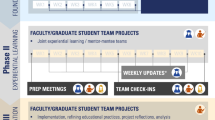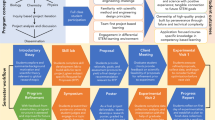Abstract
Biomedical engineering (BME) undergraduate curricula have begun to address gaps in diversity, especially in response to the newly proposed ABET diversity, equity, and inclusion (DEI) criteria. However, there is a significant lack of teaching resources, and pedagogical training available for those interested in including DEI into their course material. This is not restricted to BME and permeates many STEM fields. Thus, new engaging techniques to incorporate DEI into STEM teaching must be developed and tested. A mandatory undergraduate BME course at Stony Brook University was redesigned, to include DEI concepts directly into course content. Instructor generated resources were presented and discussed throughout the semester. These resources focused on introducing prominent scholars, engineers, and researchers, who rarely make it into textbook discussions, and their discoveries and contributions. A graded project was incorporated that asked students to generate their own resources, with the understanding that an overarching goal was to develop a library of information to be shared with our student population. After one semester, over seventy biographies have been collated. This approach worked well to highlight individual accomplishments of diverse scholars. Students appeared to be engaged with the discussion (observed through body language and participation), and appreciated researching a prominent engineer outside of those typically discussed. In the future, it will be important to link highlighted engineers more closely to course content, and to include key findings more directly within topics that are under discussion. Importantly, these efforts must be included within the graded course content to help ensure engagement, retention, and understanding.
Similar content being viewed by others
Data Availability
None.
Code Availability
None.
References
Sarraju A, Ngo S, Rodriguez F. The leaky pipeline of diverse race and ethnicity representation in academic science and technology training in the United States, 2003–2019. PLoS ONE. 2023;18: e0284945.
Sohail A, Iqbal JJ, Razaq A and Sabir MS. The impact of diversity training on commitment, career satisfaction and innovation. 2011
Shields B. Justice, equity, diversity, and inclusion curriculum within an introductory bioengineering course. Biomed Eng Educ. 2023;3:39–49.
ABET Inc. Criteria for Accrediting Engineering Programs, 2023–2024. https://www.abet.org/accreditation/accreditation-criteria/criteria-for-accrediting-engineering-programs-2023-2024/. Accessed 30 Jan 2024
ABET Inc. Criteria for Accrediting Engineering Programs, 2024–2025. https://www.abet.org/accreditation/accreditation-criteria/criteria-for-accrediting-engineering-programs-2024-2025/. Accessed 30 Jan 2024
Ceglie R, Olivares V. Representation of diversity in science textbooks. In: Hickman H, Porfilio BJ, editors. The new politics of the textbook. Rotterdam: SensePublishers; 2012. p. 49–68.
Delgato MH. Considerations of multicultural science and curriculum reform: A content analysis of state-adopted biology textbooks in Florida. 2009
Figueiredo D. Walking through the leaky academic pipeline in STEM: equity not equality needed for women and under Represented Minorities (URMs). 2023
Gregor M, Dunn M, Campbell-Halfaker D, Martin-Fernandez J, Ferrer A, Robinson S. Plugging the leaky pipeline: a qualitative investigation of untenured female faculty in STEM. J Career Dev. 2023;50:425–44.
Svensson HN. Examining the leaky pipeline: do women and men differ in their attributions for success and failure in STEM contexts? 2023
GEM Consortium. About Us - GEM Fellowship. https://www.gemfellowship.org/about-us/. Accessed 30 Jan 2024
Anyichie AC, Butler DL. Examining culturally diverse learners’ motivation and engagement processes as situated in the context of a complex task. Front Educ. 2023;8:1041946.
Lubicz-Nawrocka T, Bovill C. Do students experience transformation through co-creating curriculum in higher education? Teach High Educ. 2023;28:1744–60.
Rivadeneira J, Inga E. Interactive peer instruction method applied to classroom environments considering a learning engineering approach to innovate the Teaching–Learning process. Educ Sci. 2023;13:301.
Burnett C and Taylor Z. Developing Self Efficacy: Role Modeling and Mentoring for Undergraduates of Color. UNM Chronicle of Mentoring & Coaching. 2023
Caplar N, Tacchella S, Birrer S. Quantitative evaluation of gender bias in astronomical publications from citation counts. Nat Astron. 2017;1:0141.
Dion ML, Sumner JL, Mitchell SM. Gendered citation patterns across political science and social science methodology fields. Polit Anal. 2018;26:312–27.
Dworkin JD, Linn KA, Teich EG, Zurn P, Shinohara RT, Bassett DS. The extent and drivers of gender imbalance in neuroscience reference lists. Nat Neurosci. 2020;23:918–26.
Maliniak D, Powers R, Walter BF. The gender citation gap in international relations. Int Organ. 2013;67:889–922.
Mitchell SM, Lange S, Brus H. Gendered citation patterns in international relations journals. Int Stud Perspect. 2013;14:485–92.
Acknowledgments
Not applicable.
Funding
The author did not receive support from any organization for the submitted work.
Author information
Authors and Affiliations
Contributions
The author designed this innovative practice, implemented it into his course, and drafted, and approved the final manuscript.
Corresponding author
Ethics declarations
Conflict of interest
The author has no relevant financial or non-financial interests to disclose.
Ethical Approval
None.
Consent to Participate
None.
Consent to Publication
None.
Rights and permissions
Springer Nature or its licensor (e.g. a society or other partner) holds exclusive rights to this article under a publishing agreement with the author(s) or other rightsholder(s); author self-archiving of the accepted manuscript version of this article is solely governed by the terms of such publishing agreement and applicable law.
About this article
Cite this article
Rubenstein, D.A. A Practical Approach to Incorporating Diversity, Equity, and Inclusion Practices into Biomedical Engineering Undergraduate Courses. Biomed Eng Education (2024). https://doi.org/10.1007/s43683-024-00149-3
Received:
Accepted:
Published:
DOI: https://doi.org/10.1007/s43683-024-00149-3




